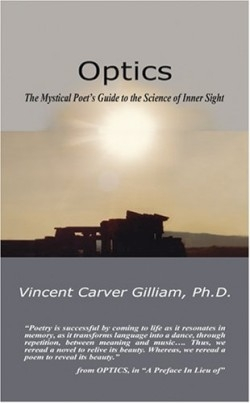Optics
The Mystical Poet's Guide to the Science of Inner Sight
The title poem of this meditative Pulitzer Prize-nominated collection of verse sets forth the author’s aim quite directly: “…For me then all important / questions are spiritual in one / form or another….” The product of Gilliam’s life’s work and exploration of spiritual traditions the poems reflect “his mystical experiences combined with his Ph.D. studies in Humanities and Religious studies” and are meant to inspire enlighten and entertain intellectually and above all spiritually.
Before one can be inspired by Gilliam’s poems however a preface photos and an introductory note must be waded through. The beginning is heavily devoted to the writer James Baldwin a man to whom the reader is given no contextual introduction. When Gilliam includes photos of a visit to his house as well as a copy of the last letter Baldwin sent him over twenty years before the book’s publication it’s difficult to understand the relevance or importance. Ultimately it detracts from and delays Gilliam’s work risking audience alienation.
Once encountered the poems are largely focused on God and nature. Gilliam exhibits versatility and precision his poems alternately unrestricted rigidly structured and sometimes playful never escaping what appears to be a love-hate relationship with free verse. He writes that he strives “to craft intriguing intellectually stimulating and challenging lyrics with the fewest words” and when he does this his poetic power sings.
In “Rung 3: Union” Gilliam’s mystical bent is plaited well with humanity: “We are / What we think / About that / Which we perceive.” And what could be an esoteric spiritual query is made accessible in “Calvary”: “Is depth / Aware of height / Or darkness / Light?” His verse is much more successful in such sparsely controlled form. His koans chant poetry and work with rhyme and sound often achieve weightless depth and resonance.
Also included as a companion to his “Sonnets to the Four Seasons” is a fascinating essay which explains his modern poetics theory deconstructing his sonnets’ “‘alliterative syncopated rhyming’ which allows poetry a dispersed harmony and a controlled rhythmic diversity.” The sonnets themselves are intriguing but they like each section of the book are preceded by quotes from other writers further dividing the reader’s attention from Gilliam’s poetic accomplishments.
Gilliam’s book would have been far more commanding had there been less indulgence of his personal journey and more focus on his poetic theory and representative poems—more trust that his vision would shine through his words alone.
Reviewed by
Christine Thomas
Disclosure: This article is not an endorsement, but a review. The publisher of this book provided free copies of the book and paid a small fee to have their book reviewed by a professional reviewer. Foreword Reviews and Clarion Reviews make no guarantee that the publisher will receive a positive review. Foreword Magazine, Inc. is disclosing this in accordance with the Federal Trade Commission’s 16 CFR, Part 255.

